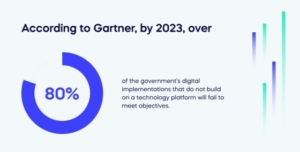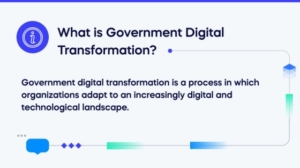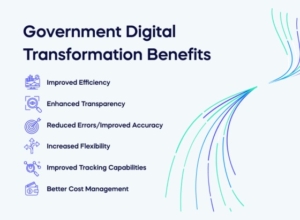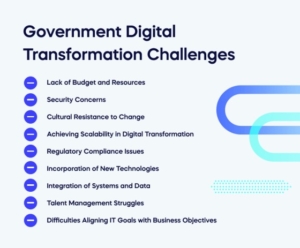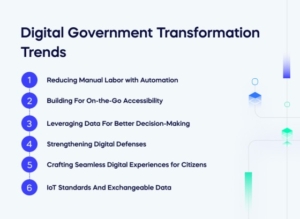Governments around the globe have been strong-handed into rapid digital transformation (DX) in the wake of the COVID-19 pandemic. Unprecedented social and economic change brought with it the rise of social distancing, remote work, and a predominant reliance on digital services.
Video-conferencing, cloud computing, digital payments, and AI-augmented solutions were already entering the social zeitgeist before the pandemic hit – gaining traction in mostly high-octane environments, such as the private sector.
In contrast, the public sector has typically proven to be one step behind when it comes to acute transformation. The ripple effects of the pandemic being were felt by both the public and private sectors. However, the responsibility of maintaining critical citizen services fell squarely on government bodies now tasked with navigating times of uncertainty.
By relying on antiquated, legacy processes (e.g., paper-based procedures for everyday tasks), workers are severely limited in their capacity to gain new abilities, leading to decreased employee efficiency and productivity, both in time and cost.
According to Gartner, by 2023, over 80% of the government’s digital implementations that do not build on a technology platform will fail to meet objectives.
Furthermore, outdated tools often require tedious manual data entry, creating an obstacle that inhibits collaboration between departments.
With citizens now expecting immediate services and information at their fingertips, the need for DX is greater than ever. Implementing digital transformation initiatives can help organizations dramatically reduce paperwork and administrative costs while improving agility and decision-making power.
This article explores the journey of government digital transformation: from paper to pixels and beyond. We will look at what is driving the need for digital change in government, who is responsible for leading it, the challenges faced during its implementation, the benefits of digitizing government processes, and current trends and possibilities for the future.
With these topics explored, readers will better understand how government operations can be modernized with digital transformation.
What is Government Digital Transformation?
Government digital transformation is a process in which organizations adapt to an increasingly digital and technological landscape.
It involves modernizing bureaucratic processes, replacing paper-based workflows, and implementing new technologies like cloud computing and artificial intelligence (AI). Government digital transformation aims to deliver more efficient and cost-effective services for citizens and businesses alike.
Government digital transformation is driven by improving efficiency, transparency, and accountability while providing more personalized services. With digital transformation, government entities can better use data collected from citizens and businesses to deliver faster and smarter public services.
For example, the EGDI is a United Nations measure that assesses the digital capabilities of public administrations by analyzing factors such as online service accessibility, telecommunications infrastructure, human capital, and government digital transformation commitment.
In their E-Government 2022 Survey, the top 15 countries in the very high EGDI group, with the highest digital readiness, are Denmark, Finland, South Korea, New Zealand, Sweden, Iceland, Australia, Estonia, Netherlands, United States, United Kingdom, Singapore, United Arab Emirates, Japan, and Malta, listed in descending order.
Ultimately, developing digital solutions enable digital transformation within government and seek to reduce costs associated with traditional bureaucracies through improved access to information and increased automation of manual processes.
The Paper-Based Burden
In the public sector, many important processes are still paper-based, making it ever more challenging to make processes errorless and efficient. This includes everything from filing taxes to registering for benefits.
Many government agencies still use paper forms for applications and permit requests. By digitizing these forms, agencies can reduce processing time and eliminate errors associated with manual data entry. In addition, digitized records can be easily shared with other government departments and agencies, allowing for more efficient collaboration.
Processes can be distributed, and data lost if a form is lost in the shuffle, and it may take weeks or even months to resolve the issue. Hence, paper-based processes make tracking progress difficult and ensuring deadlines difficult.
COVID-19 forced government bodies to adapt quickly – transitioning from their more traditional methods of operation and introducing new technologies into the mix.
As a result, the move to digital processes is long overdue.
Government digital transformation has enabled public sector organizations to tackle wider issues such as improved customer service, cost savings, and policy effectiveness. By digitizing public sector processes, efficiency can be improved, errors reduced, and taxpayers’ money saved. In the end, it’s a win-win for everyone involved.
Who is Responsible For Digital Government Transformation
The digital transformation of government is a large and complex undertaking, requiring coordination between a wide range of stakeholders. Identifying who or what is responsible for driving the process can be difficult, but several key actors have an essential role to play.
At the highest level, countries’ political leadership sets down the broad policy vision and objectives for transforming how public services are delivered. One example is the UK’s ‘Government as a Platform’ (GaaP) initiative, which leveraged a top-down approach to modernize public services for citizens using data-driven technology.
However, no government can achieve its policy goals without strong leadership from the public sector itself. Public servants need to understand how technology can help meet policy objectives, apply innovative thinking, and be prepared to experiment with new ideas. Public officials may also need to acquire specific skillsets or knowledge about emerging technologies like AI and blockchain to unleash their potential in transforming government processes.
Industry partners such as private companies or software developers also play an important role in bringing digital governance initiatives alive. Through working collaboratively with governments, they can develop digital solutions tailored to meet user needs while making political considerations such as data privacy and security requirements.
Overall, successful digital transformation of government requires a combination of effective policy direction from political leaders, visionary leadership from public servants, and effective partnership with external organizations in the industry. By leveraging the expertise of all these stakeholders, it is possible to build truly transformative technological solutions that benefit citizens worldwide.
Government Digital Transformation Benefits
Now that we better understand government digital transformation let’s explore some of the key benefits of government digital transformation initiatives below.
Improved Efficiency: Digital transformation enables governments to make processes more efficient, saving time, energy, and money.
Enhanced Transparency: Governments can use digital technologies to make more information available to citizens, providing better transparency and reducing the trust gap between government entities and the public they serve.
Reduced Errors/Improved Accuracy: By automating certain manual processes and incorporating new technologies into existing infrastructures, errors associated with traditional methods can be reduced while accuracy is improved.
Increased Flexibility: Governments can become more agile in responding to environmental changes or evolving citizen needs through digital transformation initiatives such as cloud computing or machine learning.
Improved Tracking Capabilities: New technologies such as IoT (Internet of Things) enable governments to track data in real-time, allowing them to monitor trends and make better decisions faster. This helps create a greater understanding of the performance of different governmental systems.
Better Cost Management: Government digital transformation initiatives don’t just reduce costs over time – they also help with cost management on an ongoing basis by enabling governments to evaluate their investments and ensure that resources are allocated to benefit citizens most efficiently.
Government Digital Transformation Challenges
Government digital transformation is a challenging task with far-reaching consequences for both citizens and the government. These changes present unique challenges that must be overcome for successful digital transformation.
Below, we will explore some of the most common challenges governments face regarding digital transformation.
Lack of Budget and Resources: Governments often need more support in terms of budget and resources, which can make digital transformation a challenge. This lack of funding can limit the potential for governments to invest in the technology, personnel, and tools necessary to facilitate effective digital transformation.
Security Concerns: Many government processes are highly confidential or sensitive, so security is important when undertaking digital transformation. From cyber threats to data breaches, governments must ensure that the systems they put in place are secure enough to protect both citizens’ data and government interests.
Cultural Resistance to Change: Change resistance is common in any organization but can be especially difficult for governments due to their size and complexity. In addition, governmental organizations have had long-standing cultural norms that may resist technological change—making it harder to drive successful digital transformation initiatives.
Achieving Scalability in Digital Transformation: Ensuring that all government processes are efficient, scalable, and up-to-date can be difficult. It requires balancing multiple technologies, resources, teams, and departments while also accounting for feedback from users who may have an investment in maintaining existing systems.
Regulatory Compliance Issues: Governments must comply with certain regulations depending on their industry or geographic region when undergoing digital transformation. These laws need to be taken into account when developing technology solutions—otherwise, unexpected compliance issues could arise later on down the line.
Incorporation of New Technologies: Governments must consider how best to incorporate new technologies into their infrastructure for successful digital transformation efforts. This means researching the options available and weighing the pros and cons of each option before selecting the most suitable one.
Integration of Systems and Data: Integrating systems within a government organization is essential for achieving successful digital transformation outcomes. Proper integration ensures that all parts of an organization work together seamlessly while providing easy access to data across different departments/teams within a government entity.
Talent Management Struggles: Finding people with the right skillset required for successful digital transformation can prove difficult for governments due to budget constraints or limited access to talent pools outside their organization’s networks. In addition, many established government employees may need to gain the knowledge or experience to help transition existing processes into more modernized versions using new technologies such as artificial intelligence (AI) or machine learning (ML).
Difficulties Aligning IT Goals with Business Objectives: Governments need business objectives aligned with IT goals to succeed when undergoing digital transformations. Otherwise, silos will form between teams/departments, making it hard for everyone involved in the process to understand how it fits into the overall plans or operations of the organization.
Digital Government Transformation Trends
As we know, digital government transformation is becoming increasingly prominent worldwide, and staying up-to-date with the latest trends has never been more crucial. From reducing manual labor with automation to strengthening digital defenses, several digital government transformation trends are worth keeping an eye on. These trends include:
Reducing Manual Labor with Automation: By automating routine tasks, government agencies can free up valuable time and resources, allowing them to focus on more pressing matters.
Building For On-the-Go Accessibility: With more citizens accessing government services on their mobile devices, ensuring accessibility on the go has become critical to delivering seamless experiences.
Leveraging Data For Better Decision-Making: Collecting and analyzing data can provide valuable insights into citizen needs, allowing government agencies to make informed decisions and deliver better services.
Strengthening Digital Defenses: Cybersecurity is a growing concern in the digital age, and government agencies must prioritize implementing robust measures to protect against cyberattacks.
Crafting Seamless Digital Experiences for Citizens: At the heart of digital transformation is enhancing citizen experiences. Government agencies can improve engagement and satisfaction by creating user-friendly and efficient digital interfaces.
IoT Standards And Exchangeable Data: The Internet of Things (IoT) has become increasingly prevalent in government. Establishing standards for IoT devices and data exchange is essential to realizing its full potential.
To gain key insights into the upcoming trends that will shape the government landscape and learn how to take advantage of the benefits they offer, check out our latest article, 6 Digital Government Transformation Trends to Watch in 2023, and stay informed about the future of digital government.
How To Unlock the Potential of Digital Government
With the advent of digital technologies, many government services can now be accessed online through websites and mobile apps – waving goodbye to traditional services that have long been delivered in person through brick-and-mortar offices.
According to Statista, transactional services remain the most popular features on e-government websites, and 139 countries enabled citizens to file taxes online in 2018.
From paper to software, the public sector has undergone a major digital revolution, leading governments to make greater use of technology to improve efficiency and effectiveness in how government services are delivered.
In 2022, Denmark led the way in digital infrastructure development, with the UN scoring a near-perfect EGDI rating of 0.9717. Apart from transactional services, citizens can access forms, updates, and archived information about education, the environment, health, employment, and social protection.
CIOs and digital leaders within government need to know the best ways to utilize technology to drive effective digital transformation. Here are a few tips for maximizing its value:
- When involving everyone in the process, ensure their roles are considered and they understand the reasoning behind your technology-driven decisions.
- Take the time to assess how technology can be used to facilitate new ideas and services while harnessing existing resources.
- Utilize a secure, agile platform that can scale with emerging trends and changes in industry standards and accommodate varying levels of access and usage control.
- Reimagine and refine current full-cycle operations, and craft innovative digital services to provide value and automation components of the whole process to revolutionize the citizen experience.
- Leverage automation tools such as AI, machine learning, and RPA to streamline manual processes while ensuring business continuity and compliance with minimal disruption or cost.
- Always strive for user-centric design, producing intuitive, easy-to-use digital solutions that fit within established organizational cultures and operations for the greatest success rate possible.
Modernizing Governance: The Leap From Paperwork to Pixels
The digital age has undoubtedly shifted government bodies’ operations, leading to a monumental leap from paper-based systems to utilizing new and emerging technologies. In the early 2000s, governments worldwide began recognizing the potential and efficiency of digitization, introducing new measures that enabled more effective communication and governance.
Fast forward, and technology adoption has rapidly accelerated over the past decade. Governments are now actively investing in developing technology solutions that can help solve critical issues such as data privacy and citizen engagement. This transformation is evident in leading countries like Estonia, which has committed to becoming a fully digital society by 2025. Estonia’s “e-Estonia” has seen digitally signed documents replace paper-based equivalents for voting, taxes, and healthcare services, giving citizens more control over their data.
By August 2022, Estonia had implemented more than 80 AI use cases in its government. Aiming to invest 20M euros, the country approved its second national AI strategy – the Kratt Strategy – for 2022-2023. This strategy is designed to ensure further advances in Artificial Intelligence to make processes more efficient and beneficial to society.
Estonia sets an example for other nations and is committed to becoming a fully digital society. Other countries can benefit from similar initiatives by investing in technology to improve government operations’ efficiency and improve citizens’ lives.
This could mean adopting digital systems for functions such as voting, paying taxes, accessing health services, and leveraging artificial intelligence (AI) and big data for more accurate decision-making.
This may also include leveraging decentralized systems such as blockchain technology, which could provide a more secure system for securely storing and sharing citizen data. Cloud computing, robotics, and natural language processing (NLP) could also allow governments to process unprecedented information quickly and accurately.
With many ambitious digital transformation plans underway exploring AI, big data, and other nascent technologies, we predict nations worldwide will wholeheartedly embrace technological solutions for improved governance. By leveraging these capabilities, governments have the potential to find optimal solutions that promote stability and progress for their citizens.


